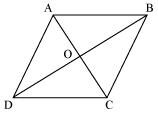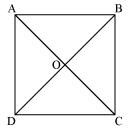Sponsor Area
Quadrilaterals
The angles of quadrilateral are in the ratio 3: 5: 9: 13.
Find all the angles of the quadrilateral.
Let the common ratio between the angles be x. Therefore, the angles will be 3x, 5x, 9x, and 13x respectively.
As the sum of all interior angles of a quadrilateral is 360º,
∴ 3x + 5x + 9x + 13x = 360º
30x = 360º
x = 12º
Hence, the angles are
3x = 3 × 12 = 36º
5x = 5 × 12 = 60º
9x = 9 × 12 = 108º
13x = 13 × 12 = 156º
If the diagonals of a parallelogram are equal, then show that it is a rectangle.

Let ABCD be a parallelogram. To show that ABCD is a rectangle, we have to prove that one of its interior angles is 90º.
In ΔABC and ΔDCB,
AB = DC (Opposite sides of a parallelogram are equal)
BC = BC (Common)
AC = DB (Given)
∴ ΔABC ≅ ΔDCB (By SSS Congruence rule)
⇒ ∠ABC = ∠DCB
It is known that the sum of the measures of angles on the same side of transversal is 180º.
∠ABC + ∠DCB = 180º (AB || CD)
⇒ ∠ABC + ∠ABC = 180º
⇒ 2∠ABC = 180º
⇒ ∠ABC = 90º
Since ABCD is a parallelogram and one of its interior angles is 90º, ABCD is a rectangle.
Show that if the diagonals of a quadrilateral bisect each other at right angles, then it is a rhombus.

Let ABCD be a quadrilateral, whose diagonals AC and BD bisect each other at right angle i.e., OA = OC, OB = OD, and ∠AOB = ∠BOC = ∠COD = ∠AOD = 90º. To prove ABCD a rhombus, we have to prove ABCD is a parallelogram and all the sides of ABCD are equal.
In ΔAOD and ΔCOD,
OA = OC (Diagonals bisect each other)
∠AOD = ∠COD (Given)
OD = OD (Common)
∴ ΔAOD ≅ ΔCOD (By SAS congruence rule)
∴ AD = CD (1)
Similarly, it can be proved that
AD = AB and CD = BC (2)
From equations (1) and (2),
AB = BC = CD = AD
Since opposite sides of quadrilateral ABCD are equal, it can be said that ABCD is a parallelogram. Since all sides of a parallelogram ABCD are equal, it can be said that ABCD is a rhombus.
Show that the diagonals of a square are equal and bisect each other at right angles.
Let ABCD be a square. Let the diagonals AC and BD intersect each other at a point O. To prove that the diagonals of a square are equal and bisect each other at right angles, we have to prove AC = BD, OA = OC, OB = OD, and ∠AOB = 90º.

In ΔABC and ΔDCB,
AB = DC (Sides of a square are equal to each other)
∠ABC = ∠DCB (All interior angles are of 90)
BC = CB (Common side)
∴ ΔABC ≅ ΔDCB (By SAS congruency)
∴ AC = DB (By CPCT)
Hence, the diagonals of a square are equal in length.
In ΔAOB and ΔCOD,
∠AOB = ∠COD (Vertically opposite angles)
∠ABO = ∠CDO (Alternate interior angles)
AB = CD (Sides of a square are always equal)
∴ ΔAOB ≅ ΔCOD (By AAS congruence rule)
∴ AO = CO and OB = OD (By CPCT)
Hence, the diagonals of a square bisect each other.
In ΔAOB and ΔCOB,
As we had proved that diagonals bisect each other, therefore,
AO = CO
AB = CB (Sides of a square are equal)
BO = BO (Common)
∴ ΔAOB ≅ ΔCOB (By SSS congruency)
∴ ∠AOB = ∠COB (By CPCT)
However, ∠AOB + ∠COB = 180º (Linear pair)
2∠AOB = 180º
∠AOB = 90º
Hence, the diagonals of a square bisect each other at right angles.
Sponsor Area
Mock Test Series
Mock Test Series





